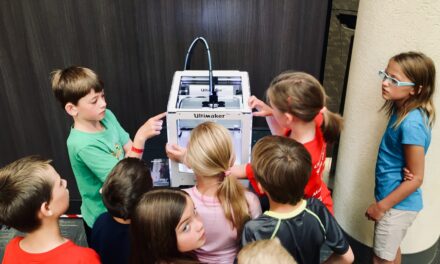It starts at birth: we put girls into pink babygrows and boys into blue ones. Then we give girls prams and dolls to play with and boys get train sets and fire engines. Research has shown that by the age of six children already see males and females in specific job roles which are reinforced by parents and teachers whose own experience has been the same. The first way to fix this is to eliminate bias and stereotyping – which includes exposing girls and boys to female role models at a younger age. You’re not only setting the role models for the girls; you’re setting it for boys too. As London ad agency MullenLowe has brilliantly demonstrated, it’s time to redraw the balance.
When it comes to the world of work, employers that look for STEM skills (science, technology, engineering and maths) simply cannot attract enough good candidates to fill the roles. Often this means looking abroad for more skilled individuals. We produce only half of the engineers we need in the UK, and of those less than 10% are women – that figure has hardly changed in 10 years. The working world is moving at lightning pace. Jobs are changing, how we work is changing, and even where we work is changing. Change is exponential. First year degree learning is out of date by year three. We must run simply to keep up. We are preparing our children for jobs which do not yet exist! How can we effect a change?
Companies wanting to be able to recruit the best also devote time and resources to working with schools and colleges to sow the seed of interest, and ignite the desire to want to be an astronaut, work with a formula one racing car team, develop advances in medicine, or be an engineer on HS2 – from app design to zoologist! Less than 1% of children know about the jobs they aspired to be from someone visiting their school. TV, film and radio are the biggest factors in their choice.
Linking businesses volunteers from all backgrounds and cultures with schools helps children to understand the link between learning and work, providing first hand career insights to motivate them to consider the widest range of future working options. STEM activities in school feed curiosity, break down gender stereotypes and open young people and children’s eyes to future possibilities. It is evident from conversations with schools and businesses that they both have the desire to connect but don’t know how to or what language to use.
The UK Government set up the Careers and Enterprise Company in 2015 to facilitate a world-class careers education, inspiring and preparing young people for the world of work. Other organisations out there to help businesses and schools to ‘find’ each other are Stemettes, Teen Tech, Founders for Schools, and The Stem Alliance.
For businesses the positives are many, including raising your company’s profile amongst local children and adults, and becoming an employer of choice for aspiring pupils. This will secure the local talent pipeline in future years, as well as demonstrate your commitment to the local community. Let schools see the diversity of your organisation by widely showcasing female employees and those of BAME ethnic groups. Make visits interactive and find out about the pupils’ interests and ambitions; give classroom talks; act as a judge for enterprise projects and competitions or take on longer-term roles such as becoming a school governor. These experiences can also be a significant contribution to company corporate social responsibility (CSR) activity as well as an opportunity for staff continuing professional development (CPD) in communication.
Other things to consider are to support a STEM Club or Code Club – that way pupils will find out about your company, and why you enjoy your industry whilst working in a small group. STEM Ambassadors are volunteers from a wide range of STEM related jobs and disciplines across the UK. They are an important and exciting free of charge resource for teachers and others engaging with young people inside and out of the classroom. They offer their time and enthusiasm to help bring STEM subjects to life and demonstrate the value of them in life and careers by sharing inspirational, first-hand career stories and running interactive activities.
Businesses could offer a two-week placement for a STEM subject teacher in their business during the school holidays, embedding them in the business world and seeing how it operates – fast moving, quick decision making, adaptability, communication, teamwork, social media: all skills now needed.
Using Zoom can mean no loss of time in travelling to and from schools either. The results speak for themselves: significant STEM activity becomes a unique selling proposition (USP) when bidding for contracts, especially from the public sector. By supporting national programmes, businesses raise their company profile in the media and government.
There is a vast pool of opportunity for businesses to engage with pupils from ages 5 to 15. A pincer approach is needed – start young and you have ten years to inspire the 15 year-olds of tomorrow. Today’s 15 year-olds meanwhile need an accelerated exposure to STEM to understand the importance of working hard in these subjects to secure a job in the future world of work. There needs to be an intense programme of reaching out from businesses to devote staff time, and if needed, financial resources to work with schools for the longer term, not just at an occasional careers fair. Schools need to play their part by including STEM in as many ways as possible and setting up STEM clubs.
Schools can also drive engagement by inviting STEM ambassadors in to run activities around national STEM days and campaigns. By putting these in the school calendar every year well in advance they can tie their activities to them: World Space week, Engineering week, Ada Lovelace Day, Women in Engineering Day on June 23rd… and be aware of big events happening each year, like the Big Bang Fair, and plan these as a trip out, rather than going to a theme park.
Schools should consider co-opting the Chair of the local Business Board as a governor to drive the STEM agenda. Often governors come from a world outside of education so can bring a fresh perspective on skills issues. If schools build ongoing relationships with businesses, they aren’t always asking the same businesses for help; but rather access to a wider range of specialisms. Schools could also work with Chambers of Commerce, manufacturing partnerships and Local Enterprise Partnerships (LEPs), as well as SMEs and FTSE companies.
Resources devoted to this should be considered an investment, not a cost, from which we’d be reaping the rewards in future years. To businesses and schools alike, the message is clear: reach out to each other now.





